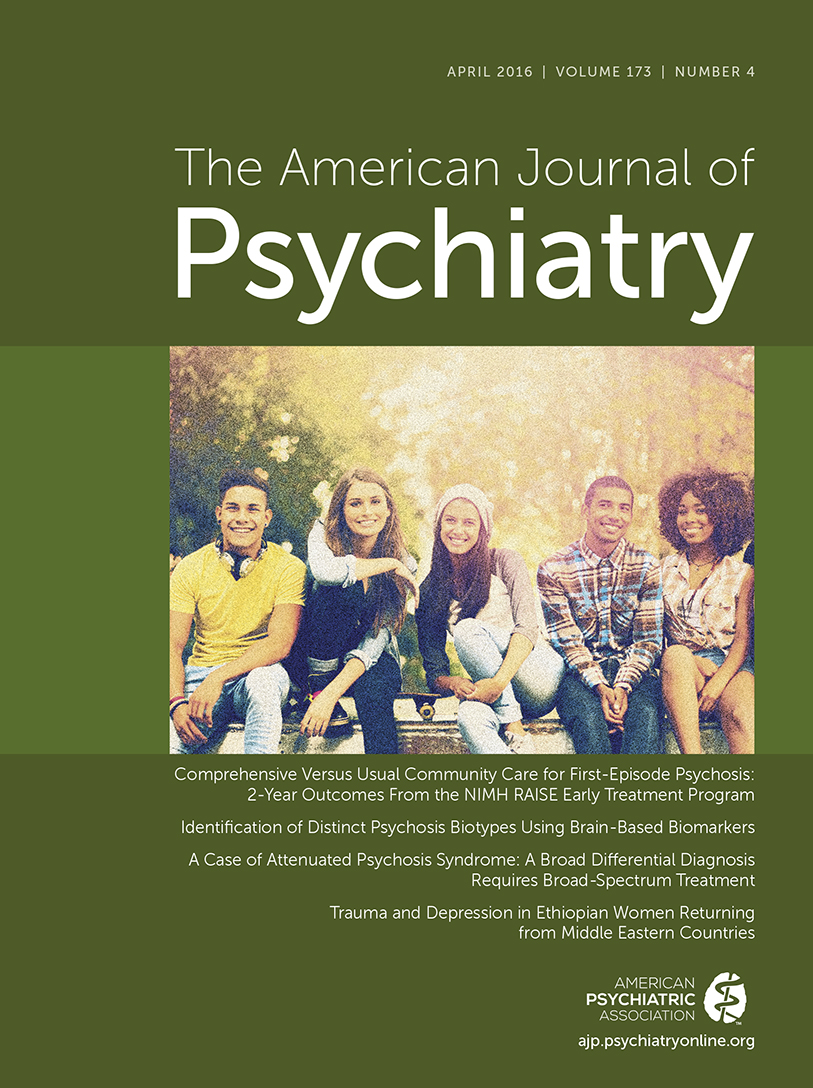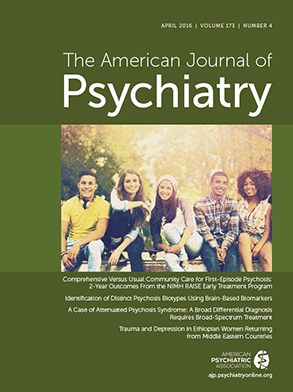Schizophrenia remains one of the most common and debilitating of all psychiatric disorders. This syndrome was first described by Kraepelin as “dementia praecox” in the late 1800s and then refined as “schizophrenia” by Bleuler in the early 1900s. The current focus on positive symptoms emerged after the introduction of antipsychotic agents in the 1950s and has remained little changed over the past 30 years.
Nevertheless, clinicians are well aware of the clinical heterogeneity of psychotic disorders, famously captured by Bleuler’s term “the group of the schizophrenias.” Psychiatry has yet to resolve these into component disorders. The recently initiated Research Domain Criteria (RDoC) initiative proposes use of neurobiological measures for development of a neuroscience-based nosology of mental disorders (
1). The present issue of the
Journal contains three articles that address the issue using complementary biomarker approaches.
Allen et al. (
2) highlight the utility of MRI perfusion measures for detecting pathology early in the course of schizophrenia. As opposed to blood-oxygen-level-dependent (BOLD) imaging, perfusion measures such as arterial spin labeling detect absolute, rather than relative, blood flow in the brain and thus can detect basal hyperperfusion across individuals. Prior perfusion MRI techniques required the use of tracer agents such as gadolinium for blood volume quantification. Nevertheless, the findings from the study by Allen et al. closely echo findings from prior perfusion imaging studies in at-risk subjects (
3), as well as results of neurochemical imaging using magnetic resonance spectroscopy (
4).
In those studies, hippocampal hypermetabolism predicted not only symptoms but also hippocampal atrophy over time (
3). Similar predictive results were observed for glutamatergic hyperactivity (
4). In rodents, administration of the
N-methyl-
d-aspartate receptor (NMDAR) antagonist ketamine produces a pattern of glutamatergic hyperactivity within cortico-limbic-thalamic circuits that resembles the pattern observed in schizophrenia (
3). As in the study by Allen et al. (
2), the hyperperfusion persists despite antipsychotic treatment, but it is reversed by using glutamatergic agents such as the mGluR2/3 agonist pomaglumetad (
3) or the NMDAR glycine-site agonist
d-serine (
5). Similarly, in at-risk individuals, treatment with
d-serine leads to reductions both in symptoms and in serum levels of interleukin-6, which may be an important mediator of the NMDAR antagonist effect (
6).
The work of Allen et al. (
2) and other recent studies of at-risk individuals show that symptoms, inflammatory changes, and hippocampal hyperperfusion are time-limited in the majority of subjects even without specific treatment, with only 10% of individuals converting to schizophrenia. However, the symptoms and associated neurophysiological deficits may significantly undermine ongoing function (e.g.,
7). As do other investigators, therefore, Allen et al. argue for earlier intervention with disease-modifying, rather than symptom-modifying, approaches (
8).
The study by Greenwood et al. (
9) reported in this issue targeted sensory gating deficits, using the measures of prepulse inhibition (PPI) and P50 gating. These are observable traits that are linked both to the personal experience of “flooding” that may occur early in the course of schizophrenia and to the underlying pathophysiology (
10). Like hippocampal hyperperfusion, therefore, sensory gating may be amenable to implementation as a clinical biomarker to identify etiological subgroups, particularly those responsive to α
7-based cholinergic intervention. Moreover, both hippocampal hyperperfusion and impaired sensory gating may be manifestations of the same local circuit dysfunction within brainstem reticular pathways (
10).
Greenwood et al. (
9) found that the heritability of PPI and P50 gating is significantly higher in familial, relative to sporadic, cases of schizophrenia. Analogous to Tolstoy’s observation regarding happiness, all normal P50s may therefore be alike, but each at-risk family may harbor its own, distinct P50 abnormality. In addition, Greenwood et al. highlight the greater negative symptoms, worse global function, and lower educational achievement in familial schizophrenia, making early detection within familial cases especially important.
The third related study reported in this issue, by Clementz et al. (
11), applied neurobiological measures across psychotic disorders, rather than being restricted to DSM-based schizophrenia. The present diagnostic distinction between schizophrenia and bipolar disorder comes from Kraepelin’s classic descriptions of “dementia praecox” and “manic depressive insanity” as separate illnesses. However, as recently discussed (
12), even Kraepelin in later years became concerned about the two- versus one-psychosis concept. Furthermore, recent genetic findings show substantial overlap across disorders (
12). The approach taken by Clementz et al. is thus consistent not only with RDoC concepts, but also with the increasing likelihood that the late-life Kraepelin may have been more perspicacious than his early-life counterpart.
Clementz et al. (
11) applied a broad range of neurobiological measures to an extensive group of psychosis disorder individuals, first-degree relatives, and healthy volunteers, and they identified three “biotypes” that showed higher heritability than the initial DSM diagnoses. The biotypes differed primarily across the neurocognitive domains of sensorimotor reactivity and cognitive control, with biotype 1 showing severe deficits in both domains, biotype 2 showing deficits only in cognitive control, and biotype 3 showing the least cognitive impairment and symptoms.
An interesting feature of the biotypes is that they map closely onto available neurochemical models. In general, schizophrenia-like psychosis may be induced by NMDAR antagonists such as phencyclidine or ketamine and by dopaminergic agents such as amphetamine. However, the nature of the symptoms and neurocognitive profiles differs markedly, with NMDAR antagonists inducing high levels of negative as well as positive symptoms, and deficits in both sensory and higher cognitive function (
13) resembling biotype 1. By contrast, dopaminergic models highlight positive symptoms and frontotemporal dysfunction, similar to biotype 2. Biotype 3 comes closest to the classical description of bipolar disorder, with intact cognitive function during the euthymic state and low levels of ongoing symptoms.
As Clementz et al. (
11) point out, the different patterns of biomarkers across the biotypes may help to explain discrepancies in replicating biomarker studies across different clinical research centers. For example, individuals with biotype 1 are more likely to be recruited in inpatient settings, while those with biotypes 2 and 3 are more likely to be found in outpatient settings. Moreover, the use of biotypes may help facilitate new treatment development. A concern is that recent high-profile clinical trials have failed in part because of the extreme etiological heterogeneity of the disorder that we now call schizophrenia. Improved etiological subtyping will permit more focused, and hopefully more successful, large-scale treatment development.
Although these three articles represent important research developments, more work still needs to be done. Some measures, like hippocampal perfusion, can be obtained even now by using standard MRI technologies. Other measures, such as the neurophysiological measures in the work of Greenwood et al. (
9) and Clementz et al. (
11) could potentially be adapted to standard digital EEG recording platforms, although appropriate reference ranges would need to be defined. Still others, such as the cognitive control measures of Clementz et al., could not be used easily outside of a research setting. Fortunately, the Bipolar–Schizophrenia Network on Intermediate Phenotypes (B-SNIP) project remains ongoing and may address these issues in future iterations.
Finally, although the demonstration of heritable biomarkers will facilitate pathophysiologically based research, biotypes are still likely to be etiologically heterogeneous, with multiple discrete causes of the generalized neurocognitive impairment pattern observed in biotype 1 versus the more frontotemporal pattern observed in biotype 2. What psychiatrists want is what the rest of medicine wants—discrete disorders with objective pathology, validated diagnostic tests, and effective, mechanism-based treatments. The use of RDoC-type concepts to challenge and refine existing nosological categories (
1) is, hopefully, an important first step in this process.

